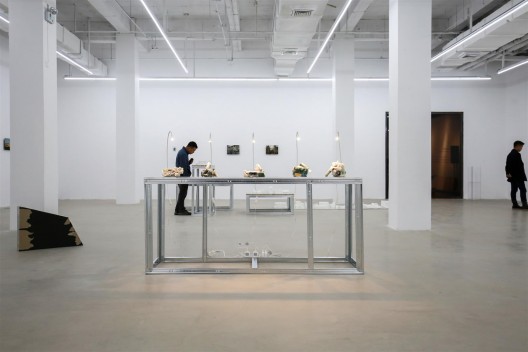“New Order, Agapanthe: Konné & Mulliez”
Surplus Space (Wuhan), Oct 29, 2016 – Feb 12, 2017
French art group Agapanthe’s solo show “New Order”, curated by Lu Mingjun, is Wuhan International Art Center’s first attempt to introduce a residency program into their exhibition process. Agapanthe was founded in 2014, and is made up of the artists Alice Mulliez and Florent Konné. They came to Wuhan for the first time in July 2016 and lived and worked there for nearly a month before returning to France. In October, they returned to Wuhan once more to complete the production and exhibition of their work. Unlike other more continuous residency programs, Agapanthe’s Wuhan experience was suspended for a time. Their thought processes followed suit, changing when they went away, and ultimately settling upon their return to Wuhan. As far as this exhibition is concerned, does its so-called new order arise out of the artists’ new activities, or is it produced from the alternation, continuation, and juxtaposition of their old and new work?
Agapanthe has always been concerned with demolition, abandonment, consumption, and other issues implicit in the process of urbanization. Their creative approach is therefore focused on the conversion and assembly of old and new materials. For instance, on display in the middle of the exhibition space is Crystals, a group of works comprised of electronic waste piles covered in sugar crystals. The sugar and the electronics have something in common: they are both easily addictive. We can limit our intake of sugar with occasional success, but modern people almost never leave their phones, their computers, or the internet alone The artists procured these abandoned gadgets on a visit to the electronic superstore neighborhood near South China Normal University. Now showing in the exhibition, the five clumps of crystal-covered electronics glitter under the display lights as if they were the latest products for sale. Perhaps discarded old gadgets and the coveted new models are the same. Capitalists are good at designing consumer products with short shelf-lives, such that the production of new products and the obsolescence of old objects is always unfolding in parallel.
In addition to the collision between old and new in this single set of works, the exhibition itself also juxtaposes pieces made by the artists at different times and in different places. This is a non-linear sort of response to the prompt of a “New Order.” Agapanthe’s new residency work, for example, called Noise, is made of paper coated with ink and torn to compose geometric plaster boards symbolizing the way in which people often opt for cheap construction materials with shorter shelf-lives in order to keep up with fast-paced urban development. In contrast, right next to Noiseis the artists’ early photographic work Pompeii series, which presents the legacy of building materials that endure from the ancient city of Pompeii. This dialogue about new and old works drawn from different regions and cultures breaks down the logical order of “from residency to exhibition,” and allows Agapanthe to view their past practice from the new vantage point of their time in Wuhan.
What is the relationship between a residency as a research process and an exhibition as a result of that research? If the exhibition is just a visual presentation of a research proposition, then what other means of output exist for data collected during an artist’s time spent living and working somewhere? In Agapanthe’s solo exhibition we cannot always see the local features of Wuhan in their work which possesses such a strong sense of form. It is also difficult for us to sense the struggles that the artists may have experienced in this new and unfamiliar context. But these invisible, unaccounted for, and even unimaginable conditions may have been built into the artists’ way of working early on. Or perhaps the emphasis of this residency project is not on establishing a new order in an unfamiliar environment, but rather on bringing together artists’ new and previous experiences and allowing the audience to apprehend the pervasiveness of these artists’ new order, and the ease with which they establish it.


Crystals series

Pompeii series

Pompeii series

Noise series